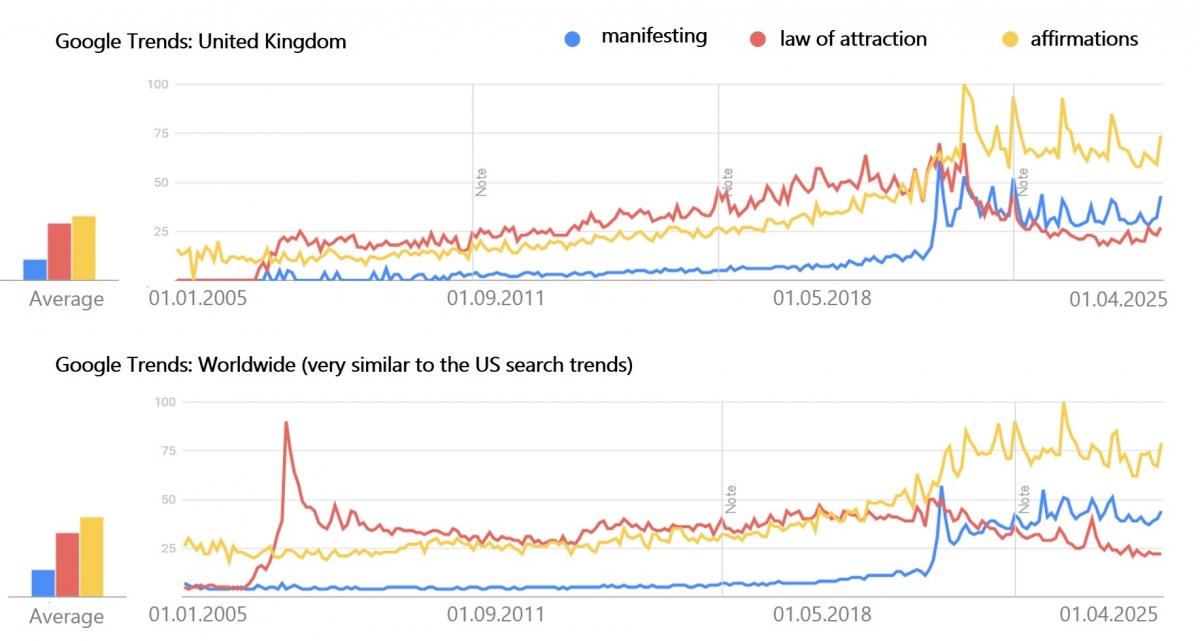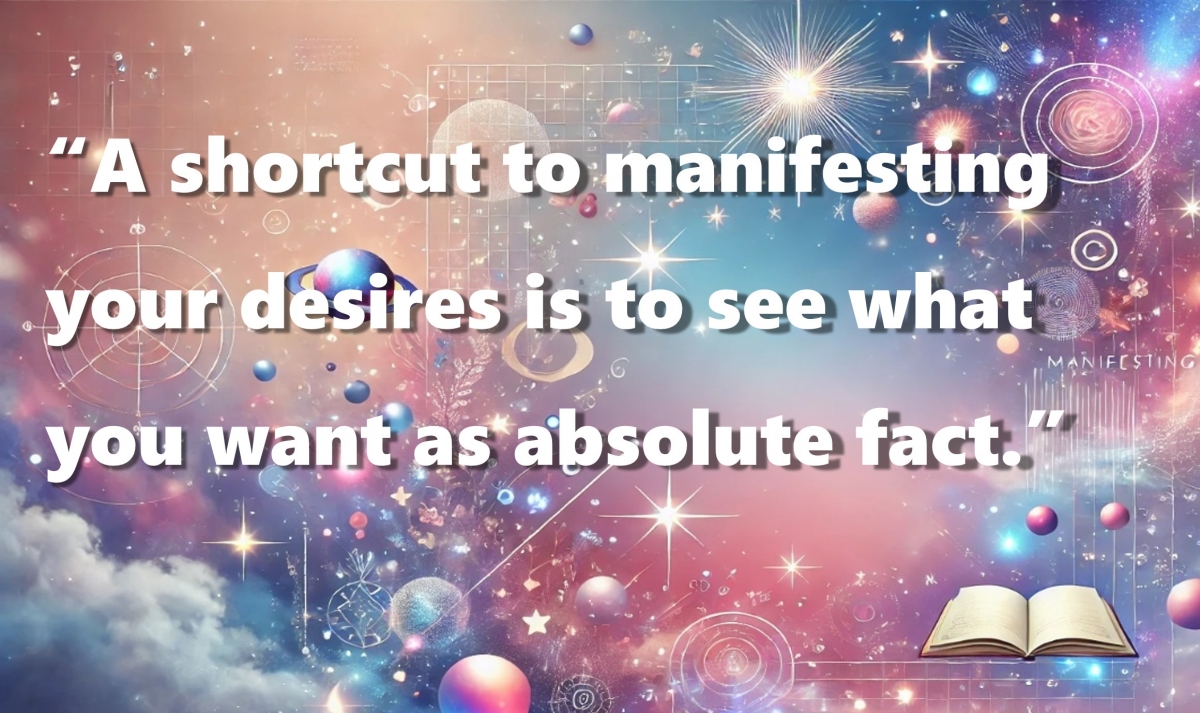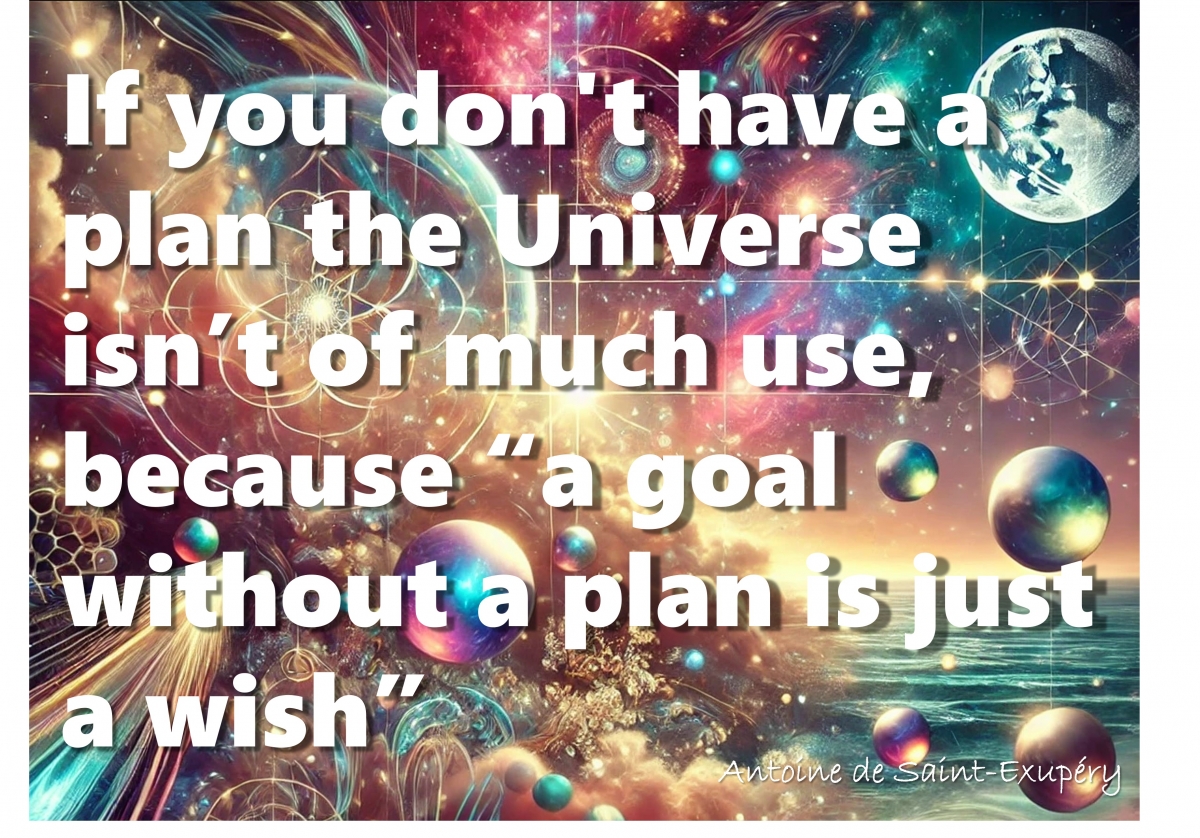What is manifesting all about? The Universe as a difficult conversational partner
Editorial Assistants: Corinna Michels and Zoey Chapman.
Note: An earlier version of this article has been published in the German version of In-Mind.
It sounds too good to be true: "You can achieve any goal with simple affirmations”. For example, people formulate: "I have clear and pure skin" or "I am grateful that I am rich" and hope that their wishes will come true under the keyword "manifestation". Speaking a wish into the Universe and then it comes true, it manifests, it becomes reality—sounds simple and if it works, it would be pretty brilliant.
However, there are a few basic rules to follow in order to communicate "correctly" with the Universe. The Universe only understands sentences in the present tense, not negations. Using hashtags like #howtomanifest, #lawofattraction, #askbelievereceive, millions of manifesting instructions can be found on all social media platforms. But how has manifesting gone so viral? And what's it all about?
Why the “manifestation” trend is spreading on social media
The belief in the positive effects of manifestations fulfils our need to see events as meaningful and predetermined. We want to believe that everything happens for a reason. Even in random events, we recognize patterns and cause-effect relationships that do not exist [1]. By manifesting, the concept of the Universe fulfils this need for meaning behind events. It influences all our lives with its invisible energies. Social media posts and books (including the bestseller ‘The Secret’ by Rhonda Byrne [2]) recommend manifestation strategies such as "Define exactly what you want and visualize it as vividly as if it were already a reality. We receive what we send out! Believe in yourself and the Universe!”.
After this brief reading of the basic assumptions of manifesting, followers are ready to go: we sit down at colorful "vision boards", sometimes creating visual collages of what we want to achieve. Or we put written affirmations on paper every day, sentences like “I am a successful influencer” or “I am grateful for my fulfilling relationship”. We imagine a positive future in a comfortable way—purely mentally, out loud, in writing or through visualization—as concretely as possible, as if it were already there. Once the work is done, the Universe can get to work, and we can sit back and relax or simply repeat our affirmations regularly.
Success stories on social media, in which people enthusiastically report how they have manifested money, love or health, revive this manifestation trend time and again, as Figure 1 shows. However, there are also clear commercial interests behind this, with “energy coaching” booming, for example, and advertising revenue from social media clicks.
 Figure 1 shows Google Trends searches for three keywords related to manifestation since the beginning of 2005. The first increase in global trends can be clearly seen in 2006 after the publication of the book "The Secret" by Rhonda Byrne. In the UK, the manifesting trend has been established since 2020.
Figure 1 shows Google Trends searches for three keywords related to manifestation since the beginning of 2005. The first increase in global trends can be clearly seen in 2006 after the publication of the book "The Secret" by Rhonda Byrne. In the UK, the manifesting trend has been established since 2020.
Basic assumptions of manifesting and where they can be found in psychology
The “law of attraction” of manifestation—we get what we send out—is not a new idea and can be supported by psychological research in certain contexts and behaviors. For example, studies show that a bad-tempered group member can bring down the mood and performance of the whole group, while good-tempered members have the opposite effect [3]. Such "contagion effects" also occur in larger social networks, even without direct contact [4].
Focusing on what we want to achieve (approach goals) rather than what we want to avoid (avoidance goals) is a proven principle of motivational psychology and is used therapeutically to pursue solutions rather than problems [5]. The shift from deficit-oriented thought processes (“I am shy and cannot assert myself”) to positive thoughts (“I am open and confidently represent my interests”), which is the goal of manifestation, can have positive effects, especially for problem-focused people. To a healthy and realistic degree, this is supported by the basic assumptions of positive psychology.
 Figure 2 shows a fictional Universe with a quote from the book “The Secret” by Rhonda Byrne.
Figure 2 shows a fictional Universe with a quote from the book “The Secret” by Rhonda Byrne.
What positive effects can the trend towards manifestation have from a psychological point of view?
The recommendation to limit oneself to a few manifestations encourages people to look at their most important goals and prioritize them. Questions such as "What is the most important thing to me at the moment?" help to clarify this. Psychologically, this makes sense because resources such as time, money and energy are limited. If we pursue many goals at the same time, we inevitably divide our resources, which slows down the achievement of goals and makes them less likely.
The second positive strategy when manifesting is to "believe in the power of our thoughts." Many who try to manifest quickly report “effects”. The process is simple to understand: When we manifest, for example, "I am more open", we gain confidence in our ability to open up. This confidence increases our self-efficacy—the belief that we can achieve something based on our own abilities. If this belief actually makes us more open when approaching people, we do not know or having a more open conversation with a new colleague, we can immediately see the first signs of success. Repeated “proof” reinforces our new openness, which can lead to a spiral of success. This process is similar to placebo thinking and is called a "self-fulfilling prophecy"—if we believe in our abilities, we are more likely to try and increase the likelihood of success. Studies show that our self-efficacy actually makes us better at achieving goals [6]. However, this only applies to events over which we have at least partial control.
At this point, a distinction must be made from manifesting—those who are self-efficacious believe that they can achieve goals through their own actions. We believe that we already have the necessary skills or can acquire them in the process in order to actively work towards a goal. However, manifestations could also occur by chance, fate or luck independently of one's own actions.
This questionnaire can be used to test whether you yourself believe in manifestation (item selection used with permission from Dixon, Hornsey & Hartley [7]):
| strongly disagree | strongly agree | ||||||
| 1. Visualizing a successful outcome causes it to be drawn closer to me | 1 | 2 | 3 | 4 | 5 | 6 | 7 |
| 2. I can speak success into existence through positive self-talk | 1 | 2 | 3 | 4 | 5 | 6 | 7 |
| 3. I am more likely to attract a successful outcome if I act like it has already come true | 1 | 2 | 3 | 4 | 5 | 6 | 7 |
| 4. I ask the Universe or a higher power to bring me success | 1 | 2 | 3 | 4 | 5 | 6 | 7 |
| 5. To attract success, I align myself with cosmic forces or energies | 1 | 2 | 3 | 4 | 5 | 6 |
7 |
Table 1: If the average of all the answers is above 4, then this test will count someone towards the “Team Manifestation”.
Related concepts from different areas of psychology, such as visualization techniques [8], also emphasize the importance of a person's action orientation and personal responsibility in achieving goals. Manifesting shifts this responsibility to the Universe, a key aspect that needs to be critically evaluated from a psychological perspective.
What makes the manifestation trend critical from a psychological perspective?
The social media trend of manifesting promises that our thoughts alone can influence reality. On an individual level, this can create a false illusion of control, unrealistic expectations or overconfidence. Studies show a link between the belief in manifesting and the belief in achieving unrealistic success, which can lead to risky behavior and financial problems [7].
If our manifestations fail, this can undermine our self-efficacy, especially if we blame ourselves. Failure to achieve hoped-for results can create pressure to think even more positively, which can increase psychological distress, stress and anxiety. Some authors even argue that manifesting can lead to "obsessive and compulsive habits" [9].
On the other hand, unfulfilled desires do not necessarily have to be attributed to a lack of personal effort, as the Universe can be held responsible for the non-occurrence: “The Universe did not want it any other way”. Without accepting responsibility, however, learning goal-directed strategies is unlikely.
There is also a serious risk that proven effective approaches from psychology or medicine will be ignored. People with serious illnesses, for example, could be treated too late, not consistently enough or not at all. The book "The Secret" [1] reports that cancer can be cured by manifesting while simultaneously discontinuing medical treatment—a narrative that has also been taken up, for example, on Oprah Winfrey's talk show [10]. From a scientific point of view, it is irresponsible to advocate only positive thinking without using necessary medical and/or therapeutic procedures.
On a societal level, the trend should also be viewed with great skepticism: If we believe in manifestation, we believe not only that positive thoughts bring about positive events, but also that difficult circumstances are energetically attracted by negative thoughts. Studies show that people who believe in manifestation are also more likely to believe in karmic justice and to agree with statements such as "In the long-run, good things happen to good people and bad things happen to bad people" [7]. However, if we perceive others' problems as self-inflicted (e.g., discrimination, serious illness), the drastic consequence is that we feel less empathy and are less supportive [11].
A deep belief in a planful Universe therefore encourages fatalistic thinking: higher powers such as the Universe could control not only our lives, but also political or social events such as wars or the climate crisis. If the Universe has a plan, who are we to presume to do anything about it? When the focus is only on manifestation and 'energy alignment', trust in scientific facts and collective efforts diminishes. Ultimately, shifting responsibility to the Universe can encourage passivity and reduce the ability to take purposeful action to actively tackle our own and society's challenges.
What strategy is better than manifesting to achieve goals?
We can conclude that positive thinking is useful in itself, but that it should not be left at that. A summary of many studies on this topic shows that simply visualizing goal states is less effective than imagining concrete behaviors that lead to these goals [12]. What is also needed to be successful are concrete plans with sub-steps for achieving goals, as well as strategies to help us overcome possible obstacles through our own efforts [14]. An effective method with practical exercises is the WOOP method (also known as "mental contrasting with implementation intentions"; www.woopmylife.org [14]). The first steps W - "Wish" and O - "Outcome" are similar to manifesting, but emphasize realistic goals that can be achieved in a few weeks. Step O - "Obstacle” explores the most important internal obstacles and resistances. In the final step, P - "Planning”, the overcoming of these obstacles is planned as precisely as possible using the if-then method: for example, "If I enter the coffee kitchen of my new workplace tomorrow, then I will introduce myself and ask the colleague present for her name". The "if" component defines a very specific situation and the "then" component provides the plan for the new behavior. The specific planned behavior in certain moments can help, for example, to overcome one's own shyness step by step. By mentally anchoring and rehearsing challenging or favorable situations for new behavior, if-then plans have proven to be a very effective strategy [13].
 Figure 3 shows abstract planets of a fictitious Universe with the alternative belief “If you don’t have a plan the Universe isn’t of much use, because “a goal without a plan is just a wish”".
Figure 3 shows abstract planets of a fictitious Universe with the alternative belief “If you don’t have a plan the Universe isn’t of much use, because “a goal without a plan is just a wish”".
Take-Home-Message
The manifesting trend promises to fulfil desires through positive thoughts alone. But science shows that it takes more than positive thinking. While it can be helpful to focus on a selection of goals, it is crucial to plan concrete steps to actively and self-determinedly achieve them.
Social media posts such as "The Universe has a better plan" should therefore be viewed critically and replaced with posts that celebrate personal responsibility and planning to tackle personal and social challenges—because we can all benefit from it.
Bibliography
[1] J. J. Exline and J. A. Wilt, "Supernatural attributions: Seeing god, the devil, demons, spirits, fate, and karma as causes of events," Annual Review of Clinical Psychology, vol. 19, no. 1, pp. 461–487, 2023, doi: 10.1146/annurev-clinpsy-080921-081114.
[2] R. Byrne, The Secret. New York, NY, USA: Atria Books, 2006.
[3] S. G. Barsade, "The ripple effect: Emotional contagion and its influence on group behavior," Administrative Science Quarterly, vol. 47, no. 4, pp. 644–675, 2002, doi: 10.2307/3094912.
[4] J. N. Rosenquist, J. H. Fowler, and N. A. Christakis, "Social network determinants of depression," Molecular Psychiatry, vol. 16, no. 3, pp. 273–281, 2011, doi: 10.1038/mp.2010.13.
[5] B. Sezer et al., " Goal motives, approach/avoidance appraisals, psychological needs, and well-being: A systematic review and meta-analysis," Motivation Science, 2024, doi: 10.1037/mot0000366.
[6] L. M. Warner and R. Schwarzer, " Self-efficacy and health," in Handbook of Concepts in Health, Health Behavior and Environmental Health, P. Liamputtong, Ed. Singapore: Springer, 2024, pp. 1–26, doi: 10.1007/978-981-97-0821-5_15-1.
[7] L. J. Dixon, M. J. Hornsey, and N. Hartley, "‘The Secret’ to success? The psychology of belief in manifestation," Personality and Social Psychology Bulletin, vol. 51, no. 1, pp. 49–65, 2025, doi: 10.1177/01461672231181162.
[8] D. Conroy and M. S. Hagger, "Imagery interventions in health behavior: A meta-analysis," Health Psychology, vol. 37, no. 7, pp. 668–680, 2018, doi: 10.1037/hea0000625.
[9] L. D'Olimpio, "What's wrong with wishful thinking? 'Manifesting' as an epistemic vice," Educational Theory, 2024.
[10] S. O. Lilienfeld, S. J. Lynn, J. Ruscio, and B. L. Beyerstein, 50 Great Myths of Popular Psychology: Shattering Widespread Misconceptions About Human Behavior. Chichester, U.K.: John Wiley & Sons, 2009.
[11] U. Rudolph, S. Roesch, T. Greitemeyer, and B. Weiner, "A meta‐analytic review of help giving and aggression from an attributional perspective: Contributions to a general theory of motivation," Cognition and Emotion, vol. 18, no. 6, pp. 815–848, 2004, doi: 10.1080/02699930341000248.
[12] S. N. Cole, D. M. Smith, K. Ragan, R. Suurmond, and C. J. Armitage, "Synthesizing the effects of mental simulation on behavior change: Systematic review and multilevel meta-analysis," Psychonomic Bulletin & Review, vol. 28, no. 5, pp. 1514–1537, 2021, doi: 10.3758/s13423-021-01880-6.
[13] P. Sheeran, O. Listrom, and P. M. Gollwitzer, "The when and how of planning: Meta-analysis of the scope and components of implementation intentions in 642 tests," European Review of Social Psychology, vol. 1, no. 1, pp. 1–33, 2024, doi: 10.1080/10463283.2024.2334563.
[14] G. Oettingen, Rethinking Positive Thinking: Inside the New Science of Motivation. New York, NY, USA: Penguin, 2014.
Picture Sources
Figure 1: via Google Trends UK Worldwide
Figure 2: Created by the authors with DALL-E
Figure 3: Created by the authors with DALL-E


